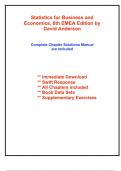Tentamen (uitwerkingen)
Solutions for Statistics for Business and Economics, 6th EMEA Edition by Anderson (All Chapters included)
- Vak
- Instelling
Complete Solutions Manual for Statistics for Business and Economics, 6th EMEA Edition by David Anderson, Dennis J. Sweeney, Thomas Williams, Jeffrey D. Camm, James J. Cochran, Michael J. Fry, Jeffrey W. Ohlmann, James Freeman, Eddie Shoesmith ; ISBN13: 9781473791350...(Full Chapters are included an...
[Meer zien]



